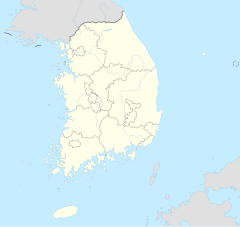Woljeongsa
| Woljeongsa | |
|---|---|
| 월정사 | |

View of Woljeongsa Temple in South Korea
|
|
| Basic information | |
| Location | 374-8, Odaesan-ro, Jinbu-myeon, Pyeongchang-gun, Gangwon-do |
| Geographic coordinates | 37°43′53.7″N 128°35′33.2″E / 37.731583°N 128.592556°ECoordinates: 37°43′53.7″N 128°35′33.2″E / 37.731583°N 128.592556°E |
| Affiliation | Jogye Order of Korean Buddhism |
| Country | South Korea |
Woljeongsa is a head temple of the Jogye Order of Korean Buddhism, located on the eastern slopes of Odaesan in Pyeongchang County, Gangwon Province, South Korea. Woljeongsa was founded in 643 by the Silla monk Jajang.
The Origin of Devotion to Manjusri Bodhisattva in Korea
Woljeongsa (Korean: 월정사, Chinese: 月精寺, Pronounced “Wol-jeong-sa”) was established by Jajang Yulsa (慈藏律師), a celebrated Vinaya Master of the Silla Dynasty. Jajang went to China to study and had an audience with the manifestation of Manjusri Bodhisattva at Taihe Lake in Shanxi Province. Manjusri then gave Jajang some of the Buddha’s cremains, his robe and alms bowl and told him to return to Silla. The bodhisattva said he would meet Jajang again on Mt. Odaesan (五臺山), located northeast of Gyeongju. Upon his return to Korea, Jajang went to (current) Odaesan and built a temporary hut. He prayed in this hut to meet the manifestation of Manjusri again but wasn’t successful because inclement weather lasted for three days.
Later, Sinhyo Geosa, a layman known to be the reincarnation of Learned-Youth Bodhisattva, resided there and cultivated his Buddhist practice. Ven. Sinui, a disciple of National Preceptor Beomil Guksa, built a small hut on the site where Jajang Yulsa had built his and also resided there. After Sinui died, the hut fell into ruin. When Ven. Yuyeon of Sudasa Temple built a hermitage on this site, it finally gained stature as a proper temple. In 1377, the hermitage burnt to the ground, and Ven. I-il rebuilt it. In 1833 it burnt down again, and in 1844 it was reconstructed by two monks, Yeongdam and Jeongam. During the Korean War, over ten of the temple’s buildings, including Chilbul-bojeon, were torched by friendly forces for strategic purposes. It was only in 1964 that reconstruction was begun again by Ven. Tanheo, beginning with the Jeokgwangjeon Hall.
The Bodhisattva and His Exquisite Pagoda
Woljeongsa has many items of cultural heritage. There are nine items of state-designated heritage that include: four National Treasures, including the Octagonal Nine Story Stone Pagoda (National Treasure No. 48), and five other designated treasures including a Seated Stone Bodhisattva (Treasure No. 139). In addition, the temple has: 17 pieces of “Tangible Cultural Heritage” designated by Gangwon-do, six pieces of “Cultural Heritage Material,” one “Historic Site,” one item of “Folklore Heritage” and one item of “Registered Cultural Heritage.” Woljeongsa’s Octagonal Nine Story Stone Pagoda is the only pagoda in South Korea that exhibits characteristics of the Goguryeo Kingdom (37 BCE - 668 CE). The beautiful Seated Stone Bodhisattva in front of the pagoda is unusual and only found in northern Gangwon-do, including Gangneung and Woljeongsa. The bronze bell of Sangwonsa, a temple associated with Woljeongsa, is the oldest temple bell produced in Korea. The bell comes with an interesting legend and boasts exquisite beauty in both its shape and the inscribed flying celestial figures on its body.
...
Wikipedia

